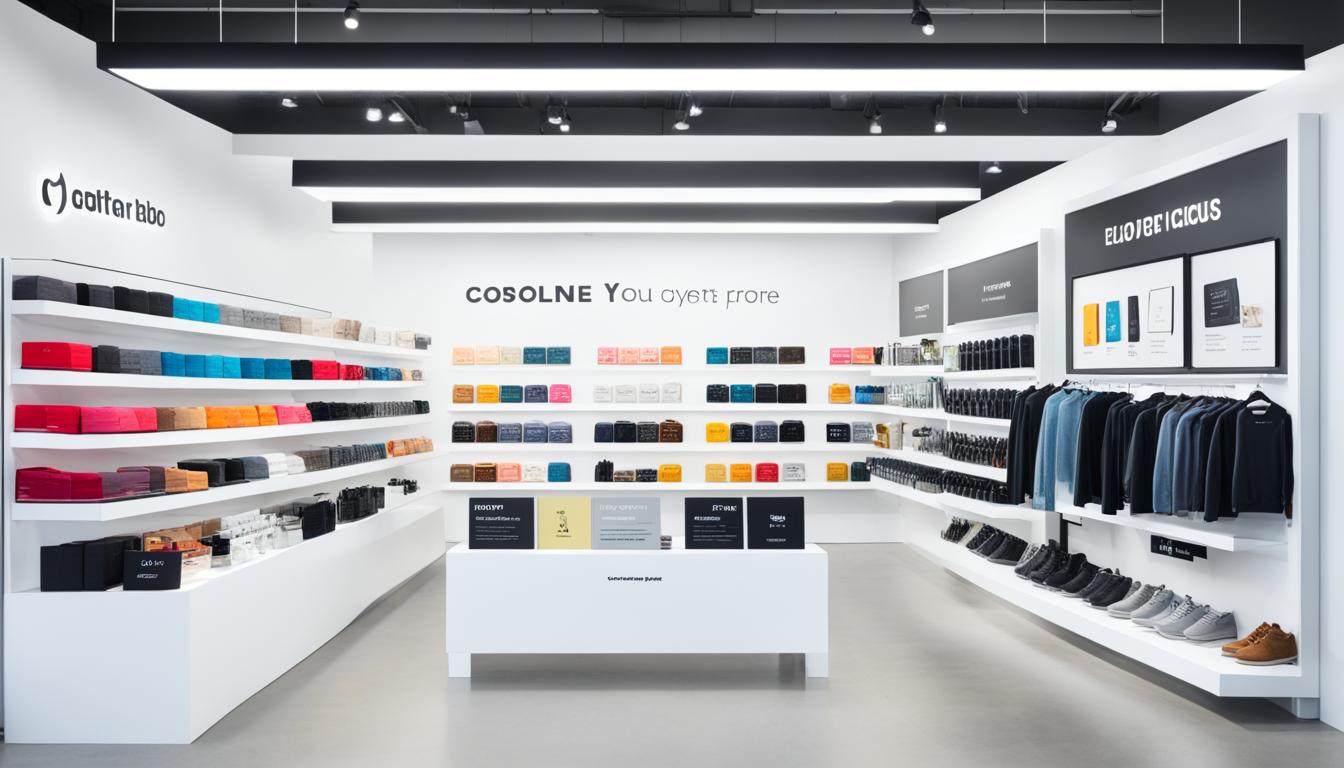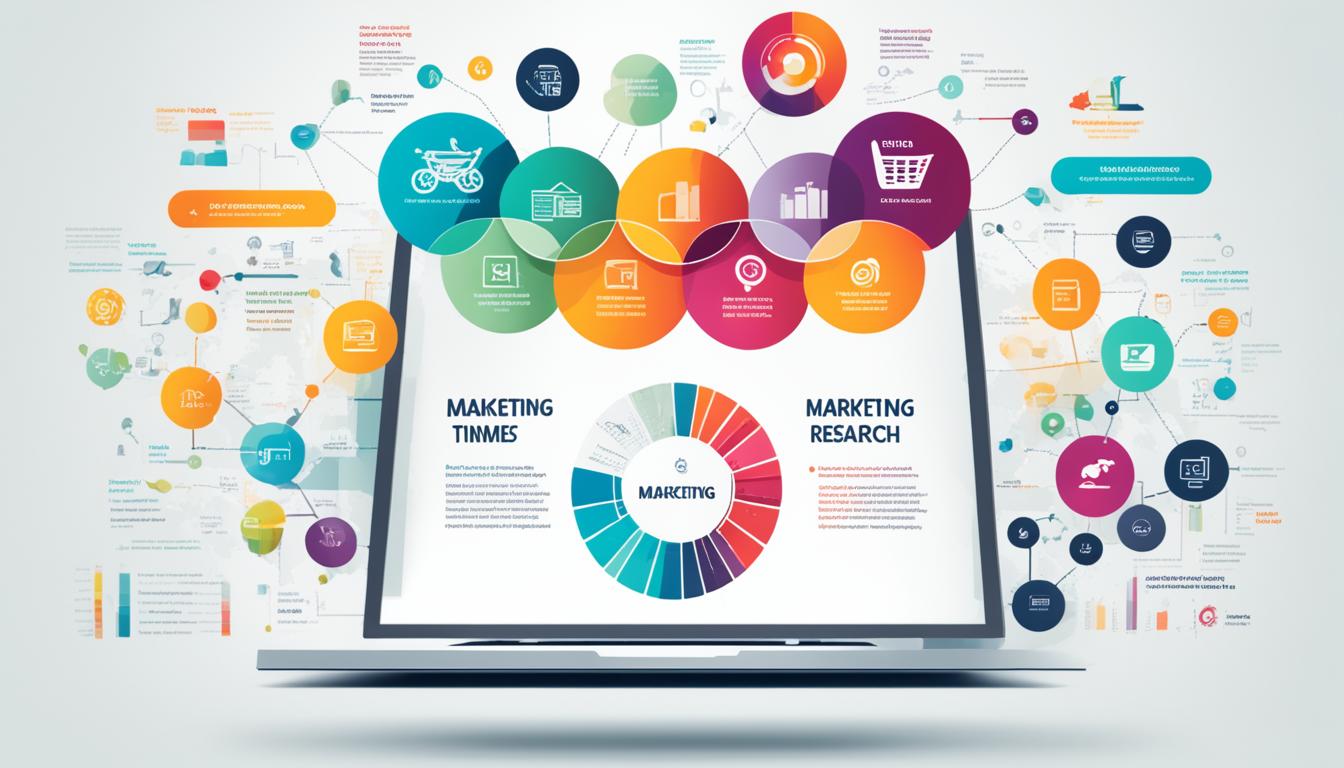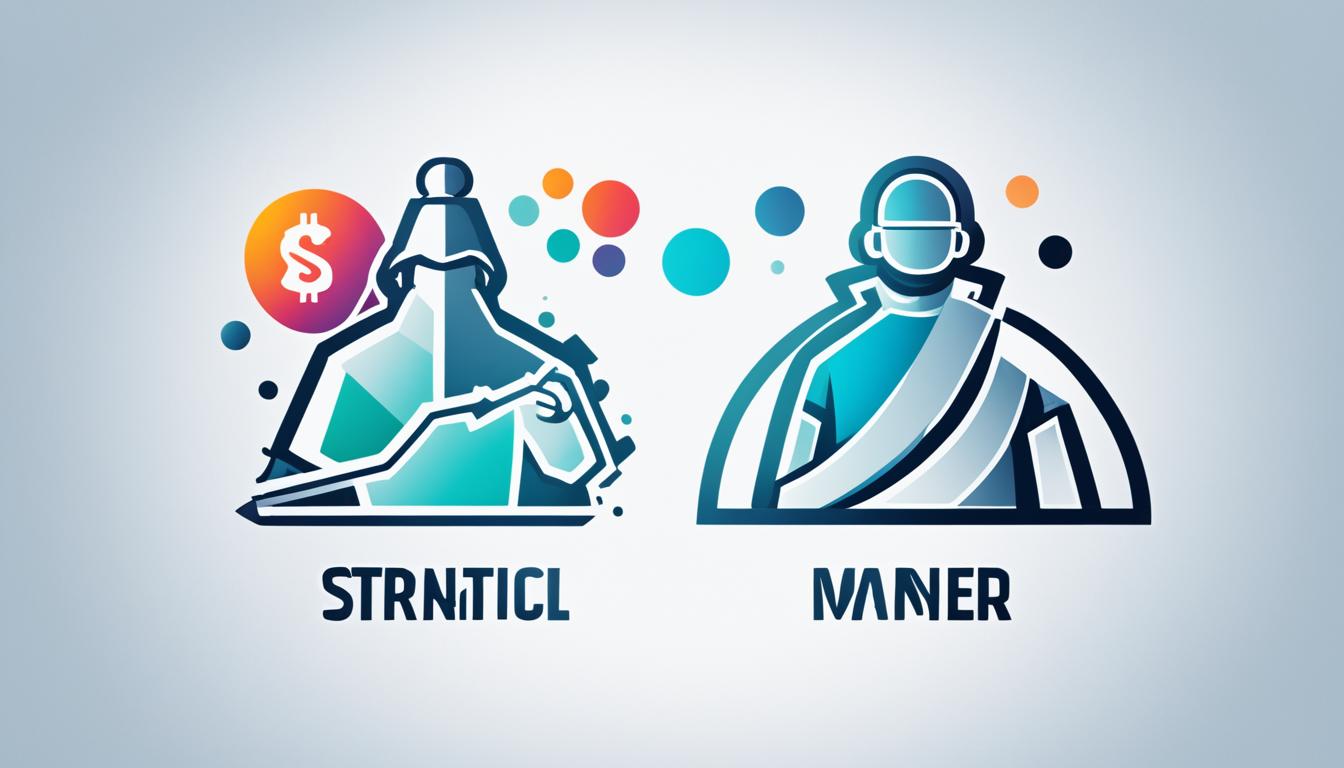Real-time bidding (RTB) is a key part of programmatic advertising in digital marketing. It lets advertisers and publishers buy and sell ad spots instantly. This is different from traditional buying, making it easier to reach the right customers.
Advertisers and publishers use platforms to bid in real-time for ad space. The one who offers the most gets to show their ad. This all happens very fast, making ads more effective.
We’re going to dive into RTB, see why it matters, and give examples. This will show how it changes digital ads.
Knowing about RTB is important for marketers. It helps them make their ads better in the digital world.
Key Takeaways:
- RTB enables advertisers to buy and sell ad inventory through programmatic auctions.
- RTB offers a more efficient ad buying method compared to traditional direct buy.
- Real-time bidding happens within milliseconds after a user clicks on a website link.
- RTB promotes relevance, saves time and money, and helps achieve desired ad campaign results.
- Understanding RTB is crucial for marketers to stay on top of digital advertising trends.
What is Real-Time Bidding (RTB)?
Real-time bidding (RTB) is a way to buy and sell ads online instantly. It uses a programmatic auction, charging by each ad view. This method is better for small to medium advertisers than direct buying.
Direct buying often requires a high minimum spend. RTB, however, lets advertisers pick from many options to find the right customer. It connects publishers with ad space to advertisers wanting to reach new customers. Here, supply-side platforms (SSPs) help publishers, and demand-side platforms (DSPs) aid advertisers.
The RTB process starts when someone clicks on a website link. It picks the top bidder in milliseconds, then shows their ad. The process uses browsing habits and costs to decide which ads show.
RTB is key in automated ad buying and selling. It helps publishers make money from their ad space. Advertisers get to display their ads to the audience they want. RTB lets advertisers adjust their spending, better their ad performance, and get more from their investment.
Real-Time Bidding (RTB) Benefits:
- Efficient ad buying method
- Access to a vast pool of ad inventory
- Real-time auction-based pricing
- Behavioral data-driven targeting
- Optimized ad spend and campaign performance
Real-Time Bidding (RTB) Process:
Let’s break down the RTB process into simple steps:
- User clicks on a website link
- Supply-side platforms (SSPs) check user behavior and ad space
- Demand-side platforms (DSPs) bid for ad space in real-time
- The bid takes milliseconds, and the highest bidder wins
- The winner’s ad is then displayed
Top RTB Platforms:
Here are some leading RTB platforms:
| Platform | Description |
|---|---|
| Google Ads | A network with many targeting options. |
| The Trade Desk | A DSP loved for its customer service and data features. |
| SmartyAds | Serves both publishers and advertisers well. |
| Amazon Ads | Great for advertising on and off Amazon. |
By using RTB and top platforms, advertisers can target their audience precisely. They optimize campaigns and get better results. RTB offers a smart and quick way to manage ad inventory.
Why Marketers Should Care About Real-Time Bidding
Real-time bidding (RTB) is changing the game in digital advertising. It allows marketers to reach their target audience more effectively. By tapping into RTB, marketers can boost their ad campaigns and get better results.
RTB is a step up from outdated advertising methods. Before, advertisers had to negotiate ad placements directly with webpage owners. This process was slow and often resulted in ads that didn’t match the viewer’s interests. RTB lets advertisers show ads that users are actually interested in.
RTB uses data from users’ cookies to guide ad bids. Supply-side platforms (SSPs) and demand-side platforms (DSPs) analyze this data. They decide if an ad should be placed based on the user’s preferences. The most relevant ad wins, making ads more engaging for viewers.
RTB also saves marketers time and money. Setting up a DSP, defining the target audience, and planning the budget automates the ad buying. The DSP uses this info to improve ad spend and campaign performance. This saves time and ensures budgets are spent wisely.
Moreover, RTB helps marketers hit their campaign goals accurately. They can target their ideal customers using RTB’s advanced options. This precise targeting leads to more engagement and more conversions.
As digital advertising keeps evolving, marketers must keep up with new methods like RTB. RTB helps save time and money, ensures relevant ads, and enhances campaign results. It’s a key tool for pushing advertising forward.
Top RTB Platforms
Several top platforms are available for running real-time bidding (RTB) ads. These platforms provide the tools and ad inventory needed for successful campaigns. Let’s look at some of the leading platforms in this area.
1. Google Ads:
Google Ads is widely known and has a huge display network. It gives marketers access to thousands of websites for their RTB ads. The software is user-friendly, helping to manage and optimize campaigns effectively.
2. The Trade Desk:
The Trade Desk is praised for its outstanding customer service and rich data. It connects with over 250 top-level partners, offering a broad range of ad inventory. This makes it a reliable choice for executing RTB campaigns.
3. SmartyAds:
SmartyAds serves both publishers and advertisers on its independent ad exchange platform. It shows a clear, detailed view of the RTB process. This allows for comprehensive campaign management.
4. Amazon Ads:
Amazon Ads is perfect for marketers focused on selling products on Amazon and other platforms. Its DSP reaches customers likely to buy, using Amazon’s large customer base. This approach aids in running successful RTB campaigns.
These leading RTB platforms give marketers the tools, ad inventory, and support needed to succeed. By using these platforms, marketers can effectively reach their target audience and improve their campaign outcomes.
Example of RTB in Action
Let’s see how RTB works with an example. Imagine Jake, an intern, looking for vacation rentals. He uses Airbnb, VRBO, and Google one evening. The next day, he finds an Airbnb ad on the Verywell Mind website. This shows RTB at work.
When Jake visits the site, the Verywell Mind’s supply-side platform (SSP) checks his cookies. It spots his search for a place to stay. The SSP talks to an ad exchange to find interested advertisers. Airbnb bids the highest and gets to show Jake their ad.
This whole process is super quick, happening in milliseconds. It makes sure Jake sees ads that match his interests. This boosts the chance of him clicking on the ad.
RTB vs. Programmatic Buying
Real-time bidding (RTB) is a popular way to buy digital ads. Still, it’s just one part of programmatic buying. Programmatic buying uses tech to streamline digital ad buying, moving away from traditional methods. RTB lets advertisers buy ad space in real-time auctions, which can be very beneficial.
While RTB is common, other methods within programmatic buying are also useful. Programmatic guaranteed deals are one example. These involve direct agreements with publishers. Advertisers can secure ad space upfront, avoiding real-time auctions. This approach offers more predictability over ad placements and costs.
Programmatic buying, including RTB, has many benefits over old-school methods. It automates ad buying and placing, saving lots of time and effort. It also uses data for better targeting and decisions, making ad campaigns more powerful.
Beyond RTB, advertisers have other choices in programmatic buying. They can go for programmatic guaranteed deals or direct contracts. This lets them buy ad space without the stress of auctions. It adds more control and accuracy to their digital ad strategies.
Benefits of RTB and Programmatic Buying
- Efficiency: Programmatic buying automates the ad buying process, saving time and resources compared to manual buying.
- Relevance: Real-time optimization and data analysis allow for highly targeted ad placements, increasing relevance and engagement.
- Cost-effectiveness: Programmatic buying enables advertisers to optimize their budgets by placing bids based on impression value and the desired target audience.
- Flexibility: Programmatic buying offers various buying models, including RTB, programmatic guaranteed, and direct contracts, catering to advertisers’ specific needs and objectives.
- Transparency: Advertisers gain access to data and insights regarding ad performance, audience demographics, and campaign metrics, empowering them to make data-driven decisions.
RTB and programmatic buying are changing how digital ads work. They give advertisers powerful tools and strategies to hit their goals. These methods help get the most out of ad budgets, target the right people, and run effective ad campaigns.
The Difference Between RTB and Ad Exchange
In digital advertising, you often hear about Real-Time Bidding (RTB) and Ad Exchange. They are related but have key differences.
An Ad Exchange is a digital spot for buying and selling ad space in real-time. It connects advertisers with publishers smoothly. Advertisers find a variety of ad space on the exchange.
RTB, however, is how ads are placed through the ad exchange. It’s a real-time buying and selling process. In RTB, advertisers bid on ad space. The highest bidder gets to place their ad. This system helps show ads to the right people at the best time, raising the chance of engaging them.
Using RTB on an ad exchange lets advertisers reach their audience well. It fills up ad space quickly. This maximizes chances for advertisers to meet their target customers.
So, the ad exchange is where ads are traded, and RTB is how it’s done. Together, they help make digital ads successful.
Now, let’s explore how RTB differs from programmatic buying in our next section.
RTB vs. DSP vs. SSP
Real-time bidding (RTB), demand-side platforms (DSPs), and supply-side platforms (SSPs) are key in programmatic advertising. They automate the ad buying and selling process.
A DSP helps advertisers bid on ad impressions easily. It connects them to a wide range of ad spaces. This lets them find the right audience without hassle. DSPs use smart algorithms and data to help enhance ad campaigns.
An SSP is for publishers looking to sell ad space. It helps them earn money from their website traffic. Publishers use SSPs to manage their ad inventory better, aiming for the highest earnings.
The RTB process is where DSPs and SSPs talk in real-time. This buying and selling of ad impressions happens through auctions. This way, advertisers get to display their ads to the right people. Meanwhile, publishers get the most out of their ad spaces.
Integration of RTB, DSPs, and SSPs
The combination of RTB, DSPs, and SSPs plays a big role in ad delivery. As soon as someone visits a website, an SSP checks the ad spaces. Then, it asks DSPs to make offers. The DSPs figure out the ad impression’s worth and bid. The top bid gets the space, and all this happens fast.
RTB, along with DSPs and SSPs, makes targeted and efficient ads possible. They ensure ads reach the right audience smoothly. This approach makes programmatic advertising campaigns more effective.
How RTB Maximizes ROI at Pathlabs
At Pathlabs, Real-Time Bidding (RTB) helps our clients get the most for their money. We know RTB’s value and always look for new Demand-Side Platforms (DSPs). This ensures our clients target their audience well without overspending.
Choosing Pathlabs as your digital media agency brings big benefits. We’re experts in RTB’s complexities, guiding our clients to great campaign results. Our skills in ad positioning and reaching the right audience lead to success.
Expertise and Optimization
Pathlabs gets how RTB works and uses it to its full potential. Our experts keep up with changing trends and tech. Thus, we constantly improve our strategies for the best ROI.
We pick the best DSPs after careful analysis, tailored to your ad goals. Understanding the bidding and pricing helps us manage budgets well. This leads to cost-effective campaigns with strong outcomes.
Targeted Audience Reach
Through RTB, we pinpoint your ideal audience. Advanced targeting means your ads reach those most likely to engage. This increases chances for engagement and conversions.
Our skills in audience segmentation refine your campaign’s focus. We target by demographics, interests, and behaviors. This focused method makes your ads more effective, maximizing your ad spend.
Industry-Leading Results
Working with Pathlabs means teaming up with pros in making RTB work for you. Our track record is filled with success stories across different fields. We deliver standout results.
Our detailed reporting sheds light on how your campaigns perform. This data helps you plan smarter strategies in the future. At Pathlabs, we aim for results that help your business grow.
Pathlabs: Your RTB Partner for Success
Choosing Pathlabs as your RTB partner means trusting in our expertise to enhance your ROI. We handle the complex world of digital ads with strategic execution. This achieves the best outcomes.
Being with Pathlabs gives you the edge with RTB. It lets you reach your target audience efficiently, driving meaningful results. Let’s use RTB together to boost your advertising and elevate your business.
Team up with Pathlabs to see how real-time bidding can increase your ROI. Contact us today. We’re ready to make your advertising succeed through the power of RTB.
Conclusion
Real-time bidding, or RTB, has changed online ads for the better. It allows for smarter ad buying that focuses on what’s relevant. This means advertisers can find their audience more accurately. They get more out of their spending.
RTB helps advertisers choose from many options to find the right customer. It saves them both time and money. The auction-based pricing means they pay what’s fair. This makes sure they use their budget well. Ads that match what users want increase engagement and make campaigns more successful.
To stay ahead, marketers should embrace RTB. It takes their advertising to a new level, bringing amazing results. RTB stands out in the fast-paced world of digital ads. It offers efficient buying and meaningful ads. RTB truly changes the game.








